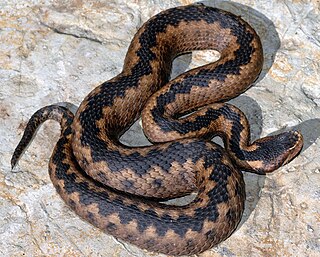Montatheris is a monotypic genus created for the viper species, Montatheris hindii, which also known by the common names Kenya mountain viper, Kenya montane viper, montane viper, and Hind's viper. Like all other vipers, M. Hindii is venomous. This is a small terrestrial species endemic to Kenya. There are no subspecies which are currently recognized as being valid.

Macrovipera, known as the large Palearctic vipers, is a genus of vipers that inhabit the semideserts and steppes of North Africa, the Near and Middle East, and the Milos Archipelago in the Aegean Sea. Like all other vipers, they are venomous. These snakes are responsible for a number of bites in Africa and Western Asia every year. They have a reputation for being ill-tempered and can inject a lot of venom, which is why they should be considered as very dangerous. Two species are currently recognized.

Pseudocerastes is a genus of vipers endemic to the Middle East and Asia. It was originally created as a monotypic genus in 1896 by Boulenger for the species Pseudocerastes persicus, but three species are now recognised: the spider-tailed horned viper ; Persian horned viper and Field's horned viper. Like all other vipers, the members of this genus are venomous.

Vipera is a genus of vipers. It has a very wide range, being found from North Africa to just within the Arctic Circle and from Great Britain to Pacific Asia. The Latin name vīpera is possibly derived from the Latin words vivus and pario, meaning "alive" and "bear" or "bring forth"; likely a reference to the fact that most vipers bear live young. Currently, 21 species are recognized. Like all other vipers, the members of this genus are venomous.

Macrovipera lebetinus schweizeri, commonly known as the Milos viper or Cyclades blunt-nosed viper. is a subspecies of venomous snake in the family Viperidae. The subspecies is endemic to the Cyclades Archipelago of Greece in the Aegean sea.
Macrovipera lebetinus cernovi, known as the Chernov blunt-nosed viper, is a viper subspecies endemic to Asia. Like all other vipers, it is venomous.
Macrovipera lebetinus transmediterranea is a viper subspecies endemic to North Africa. Like all other vipers, it is venomous.

The Lebanon viper, also known as Bornmueller's viper, is a species of venomous snake in the subfamily Viperinae of the family Viperidae. The species is native to Western Asia. There are no recognized subspecies.

The Mount Bulgar viper, also called the Bulgardagh viper is a viper species endemic to the mountains of southern Turkey. Like all other vipers, it is venomous. No subspecies are currently recognized.

Vipera darevskii, known as Darevsky's viper, is a small species of viper, a venomous snake in the subfamily Viperinae of the family Viperidae. The species is native to northwestern Armenia, northeastern Turkey, and possibly also adjacent southern Georgia. There are no subspecies that are recognized as being valid.

Vipera dinniki is a viper species native to the Caucasus Mountains region, part of Russia, Georgia, and Azerbaijan. Like all other vipers, it is venomous. No subspecies are currently recognized.

Vipera kaznakovi, known as the Caucasus viper, Kaznakow's viper, Kaznakov's viper, and by other common names, is a species of venomous snake in the subfamily Viperinae of the family Viperidae. The species is endemic to Turkey, Georgia, and Russia. No subspecies are currently recognized.

Vipera lotievi, commonly known as the Caucasian meadow viper, is a species of venomous snake in the family Viperidae. The species is endemic to Azerbaijan, Georgia, and Russia. There are no subspecies that are recognized as being valid.

Vipera nikolskii is a venomous viper species endemic to Ukraine, eastern Romania, and southwestern Russia. No subspecies are currently recognized.

Montivipera raddei or Armenian viper is a species of viper, a venomous snake in the subfamily Viperinae of the family Viperidae. The species is endemic to Armenia, Azerbaijan, Iran, Turkey, and possibly also Iraq. Two subspecies are recognized.

Vipera ursinii is a species of venomous snake in the subfamily Viperinae of the family Viperidae. It is a very rare species, which is in danger of extinction. This species is commonly called the meadow viper. It is found in France, Italy, and Greece as well as much of eastern Europe. Several subspecies are recognized. Beyond the highly threatened European population, poorly known populations exist as far to the east as Kazakhstan and northwestern China.

Wagner's viper, known as the ocellate mountain viper, ocellated mountain viper, and Wagner's viper, is a species of venomous snake in the subfamily Viperinae of the family Viperidae. The species is native to eastern Turkey and northwestern Iran. There are no subspecies that are recognized as being valid.

Montivipera xanthina, known as the rock viper, coastal viper, Ottoman viper, and by other common names, is a viper species found in northeastern Greece and Turkey, as well as certain islands in the Aegean Sea. Like all other vipers, it is venomous. No subspecies are currently recognized.

Vipera orlovi is a species of venomous snake in the family Viperidae. The species is endemic to Russia.
Vipera eriwanensis, commonly known as the Alburzi viper or the Armenian steppe viper, is a species of venomous snake in the family Viperidae. The species is native to western Asia. There are two recognized subspecies.

















